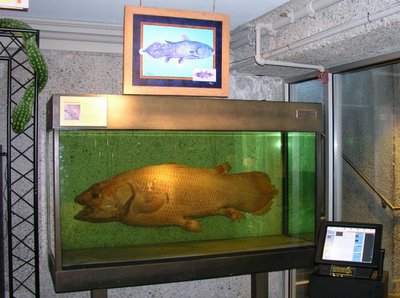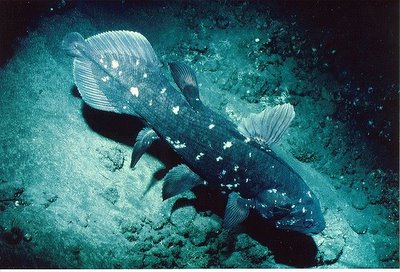Coelacanth pushed back to brink by trawlers
Always loved the story about the re-emergence of the Coelacanth. I mean, a dinosaur fish rediscovered after 400 million years!

After surviving for millions of years, the coelacanth is threatened by commercial fishing fleets
Inigo Gilmore in Tanzania
Sunday January 8, 2006
The Observer
It is not every day that you come face to face with a dinosaur dating back 400 million years, but for the fishermen in Kigombe on Tanzania's northern coast it has become almost routine.
In the middle of Kigombe, a village of simple huts on this breathtaking edge of the Indian Ocean, a young fisherman stood proudly before a large green plastic container. Ceremoniously he reached inside and hauled out a monster of a fish, slapping its 60kg (132lb) of flesh on a table, where three children gawped at its almost human-like 'feet'. This is a living fossil, a fish with limbs, a creature once believed extinct: a coelacanth.
Now it seems that man may have discovered the fish just to eradicate it, as ever deeper trawling throws up serious fears for the already dwindling populations of the fish, which lives at depths of between 100 and 300 metres (328ft to 984ft).
The appearance of these creatures off the Tanzanian coast is a dramatic and as yet unfinished chapter in the extraordinary story of the coelacanth, an ancient fish that was 'rediscovered'. The coelacanth evolved 400 million years ago - by contrast Homo sapiens has been around for less than 200,000 years - and was believed to have gone the way of the dinosaurs until one was caught off the coast of South Africa in 1938.
The fish has a remarkable physiology - it has no backbone, but an oil-filled 'notochord' and four limb-like appendages, with stubby fins. It has a double tail and gives birth to as many as 26 young at one time. It is believed to gestate for 14 months and may live for more than 80 years. The young develop inside the mother, attached to the outside of a huge yolk-filled egg of about 100mm (3.9in) in diameter.
The world waited another 14 years before the second coelacanth was 'discovered' in the Comoros, off the East African coast. Then several more were found and it was photographed for the first time in its natural habitat. But it is the appearance of the coelacanth off Tanzania that has raised real worries about its future.

It was in August 2004 that the local fisheries authority first received a phone call saying fishermen in Kigombe had caught a 'strange' fish. Officials went to check and to their amazement found two specimens of Latimira chalumnae - the coelacanth. Over the next five months 19 more were netted - weighing between 25kg and 80kg. Another appeared last January, then there was a gap until the fish again turned up as The Observer visited.
The numbers are perplexing officials of the Tanga Coastal Zone Conservation and Development Programme, which has a long-term strategy for protecting the species, with the help of Irish aid. They see a connection with trawling - especially by big Japanese vessels - near the coelacanth's habitat, as within a couple of days of trawlers casting their nets coelacanths have turned up in shallow-water nets intended for sharks.
Hassan Kolombo, a programme co-ordinator, said. 'Once we do not have trawlers, we don't get the coelacanths, it's as simple as that.' His colleague, Solomon Makoloweka, said they had been pressuring the Tanzanian government to limit trawlers' activities. He said: 'I suppose we should be grateful to these trawlers, because they have revealed this amazing and unique fish population. but we are concerned they could destroy these precious things. We want the government to limit their activity and to help fund a proper research programme so that we can learn more about the coelacanths and protect them.'
Such is the paucity of resources for the programme that when The Observer visited its offices, we were shown an incredible specimen weighing 110kg - stuffed inside the office freezer. We had been asked to collect it.
As the locals helped to haul the monster into the back of a taxi, the village leaders wondered if the fish could help them attract tourists to their impoverished community. Yet one of the challenges may be to persuade the wider Tanzanian population that this is a species worth preserving.
Making our way to Tanga, with the coelacanth in the boot, Simon, The Observer's driver from Dar es Salaam, was deeply unimpressed with his unexpected passenger. He produced a pink bottle of rose poppy perfume and sprayed it liberally around the car to mask the odour seeping in.
'Why should they save this fish?' he demanded. 'This is not a good fish. It's oily and you cannot eat this, and it's a smelly fish.' Fixing me with a puzzled look, he concluded: 'It's a bad fish.'

After surviving for millions of years, the coelacanth is threatened by commercial fishing fleets
Inigo Gilmore in Tanzania
Sunday January 8, 2006
The Observer
It is not every day that you come face to face with a dinosaur dating back 400 million years, but for the fishermen in Kigombe on Tanzania's northern coast it has become almost routine.
In the middle of Kigombe, a village of simple huts on this breathtaking edge of the Indian Ocean, a young fisherman stood proudly before a large green plastic container. Ceremoniously he reached inside and hauled out a monster of a fish, slapping its 60kg (132lb) of flesh on a table, where three children gawped at its almost human-like 'feet'. This is a living fossil, a fish with limbs, a creature once believed extinct: a coelacanth.
Now it seems that man may have discovered the fish just to eradicate it, as ever deeper trawling throws up serious fears for the already dwindling populations of the fish, which lives at depths of between 100 and 300 metres (328ft to 984ft).
The appearance of these creatures off the Tanzanian coast is a dramatic and as yet unfinished chapter in the extraordinary story of the coelacanth, an ancient fish that was 'rediscovered'. The coelacanth evolved 400 million years ago - by contrast Homo sapiens has been around for less than 200,000 years - and was believed to have gone the way of the dinosaurs until one was caught off the coast of South Africa in 1938.
The fish has a remarkable physiology - it has no backbone, but an oil-filled 'notochord' and four limb-like appendages, with stubby fins. It has a double tail and gives birth to as many as 26 young at one time. It is believed to gestate for 14 months and may live for more than 80 years. The young develop inside the mother, attached to the outside of a huge yolk-filled egg of about 100mm (3.9in) in diameter.
The world waited another 14 years before the second coelacanth was 'discovered' in the Comoros, off the East African coast. Then several more were found and it was photographed for the first time in its natural habitat. But it is the appearance of the coelacanth off Tanzania that has raised real worries about its future.

It was in August 2004 that the local fisheries authority first received a phone call saying fishermen in Kigombe had caught a 'strange' fish. Officials went to check and to their amazement found two specimens of Latimira chalumnae - the coelacanth. Over the next five months 19 more were netted - weighing between 25kg and 80kg. Another appeared last January, then there was a gap until the fish again turned up as The Observer visited.
The numbers are perplexing officials of the Tanga Coastal Zone Conservation and Development Programme, which has a long-term strategy for protecting the species, with the help of Irish aid. They see a connection with trawling - especially by big Japanese vessels - near the coelacanth's habitat, as within a couple of days of trawlers casting their nets coelacanths have turned up in shallow-water nets intended for sharks.
Hassan Kolombo, a programme co-ordinator, said. 'Once we do not have trawlers, we don't get the coelacanths, it's as simple as that.' His colleague, Solomon Makoloweka, said they had been pressuring the Tanzanian government to limit trawlers' activities. He said: 'I suppose we should be grateful to these trawlers, because they have revealed this amazing and unique fish population. but we are concerned they could destroy these precious things. We want the government to limit their activity and to help fund a proper research programme so that we can learn more about the coelacanths and protect them.'
Such is the paucity of resources for the programme that when The Observer visited its offices, we were shown an incredible specimen weighing 110kg - stuffed inside the office freezer. We had been asked to collect it.
As the locals helped to haul the monster into the back of a taxi, the village leaders wondered if the fish could help them attract tourists to their impoverished community. Yet one of the challenges may be to persuade the wider Tanzanian population that this is a species worth preserving.
Making our way to Tanga, with the coelacanth in the boot, Simon, The Observer's driver from Dar es Salaam, was deeply unimpressed with his unexpected passenger. He produced a pink bottle of rose poppy perfume and sprayed it liberally around the car to mask the odour seeping in.
'Why should they save this fish?' he demanded. 'This is not a good fish. It's oily and you cannot eat this, and it's a smelly fish.' Fixing me with a puzzled look, he concluded: 'It's a bad fish.'

0 Comments:
Post a Comment
<< Home